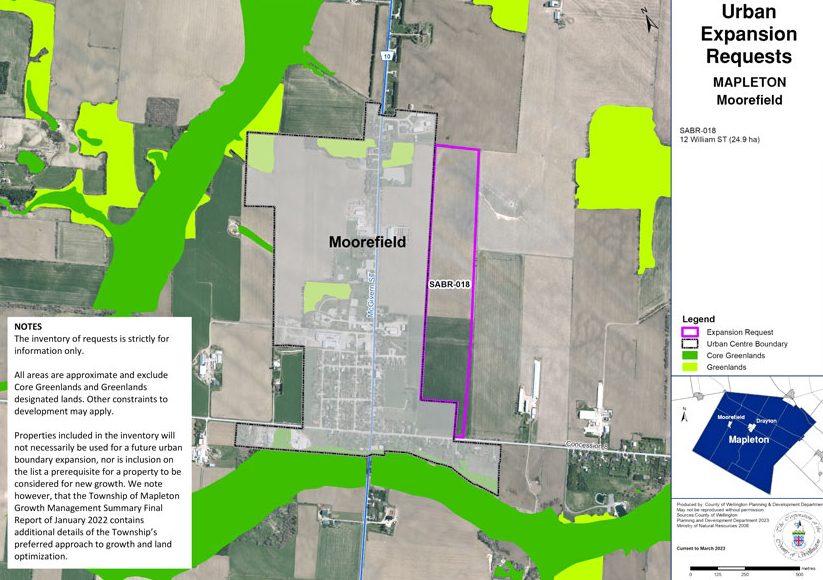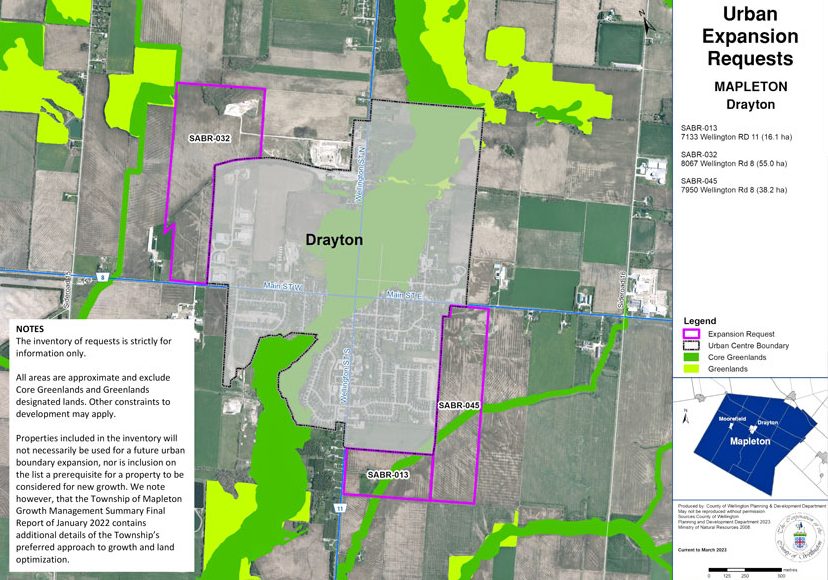MAPLETON – Council here received some advice from Wellington County planning staff on how to proceed with requests for expanding urban boundaries within the township, in the wake of provincial changes pre-empting the county’s work in that area.
Sarah Wilhelm, manager of policy planning for the county, told Mapleton council on May 23 the township was left out of unilateral boundary expansions mandated through the province’s modifications to Wellington County Official Plan Amendment (OPA) 119 in its April 11 approval of the amendment.
“There were some big surprises … and that included major mapping modifications that added land to urban boundaries. And you might notice that you’re not on that list,” Wilhelm explained.
The unilateral urban boundary expansions mandated by the province included over 1,000 acres of land mostly in Centre Wellington, but also including Guelph/Eramosa and Minto.
“Urban boundary expansions were not part of Official Plan Amendment 119 and the province did not consult with county or township staff about these expansions that were developer-initiated. I just wanted to make sure everyone was aware of that,” Wilhelm noted.
“So what does that mean for you? … Unfortunately, that your clearly-articulated needs were not met through provincial modifications.”
A land needs assessment prepared by the county as part of the Municipal Comprehensive Review process indicated 134 hectrares (331 acres) in Mapleton had been included in an inventory of urban boundary expansion requests.
The majority of the requests were for land around Drayton, with about 25 hectares (62 acres) surrounding Moorefield.
“If you spoke to the province, they would probably say, ‘Well, why didn’t you ask?’ And to that, I would say, how could you possibly know that that was an option available to you because it wasn’t even part of the amendment, it hasn’t gone through a public process? So, it’s been surprising to say the least,” said Wilhelm.
She suggested the township and landowners consider multiple options for moving forward with boundary expansion requests in the future.
“It’s probably best to go with as many options as you can, just to make sure that you’re successful,” she stated.
Wilhelm noted the county’s OPA 120, currently before the province, is one option.
“And that doesn’t include urban boundary expansions, either, but it includes our growth forecasts (and) it is an opening, or an opportunity, to request modifications through the province,” she explained, adding the province has indicated it would prefer to see modification requests come in through formal Environmental Registry of Ontario postings.
However, she noted, “they can’t tell us when they’re going to do that.
“So if the township sees fit to support some of these requests through that mechanism, I would suggest that you go ahead and submit a request and then, when the formal posting for comments comes out, submit them again,” she stated.
Wilhelm told council “significant” changes to provincial planning policy including “removing the concept of a Municipal Comprehensive Review,” as well as eliminating requirements for intensification and density targets, while “still encouraging” them.
“The province has made it easier to expand and identify new settlement areas. That was a prohibition in the growth plan, to identify new settlement areas …” she stated.
“So moving forward, if this document is approved the way that they’ve proposed it, settlement boundary expansions could come forward at any time. And they can be privately initiated, as well.
“And more importantly too is that the province has indicated … the forecasts are minimums, and now they’ve kind of doubled that up that the land needs are a minimum as well. So it becomes a bit less of an accounting exercise,” she added, noting the moves would provide municipalities with “more flexibility” going forward.

Map showing inventory of urban boundary requests around the village of Moorefield. County of Wellington image
Proposed provincial policy changes will also have agricultural impacts, Wilhelm told council.
“The big change, there is much more potential for growth in the rural areas of the county and, in your case, prime agricultural lands entirely, and less protection for agricultural resources,” Wilhelm said.
She added it is “quite surprising to see that prime agricultural severances are being opened up.
“And not only allowing for three residential severances from a farm, but requiring the policies to allow for that. So not allowing municipalities to be less restrictive.”
While Municipal Affairs and Housing Minister Steve Clark has since indicated the province may back down on some of the rural residential proposals under pressure from farming organizations, Wilhelm noted the policies as currently proposed would have “pretty significant cumulative impact” and “might make us want to look a little bit differently at servicing in the rural area or think about what impacts might come for failed systems.
“The presence of these lots also creates a restriction for new or expanding livestock facilities for farmers,” she pointed out.
Mayor Gregg Davidson thanked Wilhelm for her presentation, noting “it’s a tough situation that the province has put all municipalities through.
“I can’t imagine being Centre Wellington right now, with the amount of growth that’s been thrown at them that they weren’t planning for, nor have any servicing (for).”
Councillor Michael Martin asked Wilhelm if she anticipated changes to minimum separation distance regulations in light of the push for increased residential development in rural areas.
“If say, on a 100-acre farm, you sell off two acres, two one-acre properties, at the front and then you go to expand your dairy operation or your hog barn or something and now all of a sudden, the MDS calculations come in, and suddenly you can’t because the person living on that property is from, I don’t know, Cambridge, and doesn’t like the smell of the barn and doesn’t want it to grow … is there going to be changes to that as well?” he asked.
Wilhelm said the new lots would need to meet MDS requirements “but you can get a minor variance.
“And now with the changes the province has made, private citizens can’t appeal minor variances. And so that concern has been raised and also the fact if there’s a disagreement about how you’ve even completed the calculations, how could we even resolve that without having that appeal mechanism?”
She continued, “I have obviously heard a lot about minimum distance separation, but then I heard someone saying, ‘Oh, well, is that part of the problem?’
“And then I think … the government could choose to do something with that, too. So it’s a fair question.”
Council received Wilhelm’s presentation as information.




